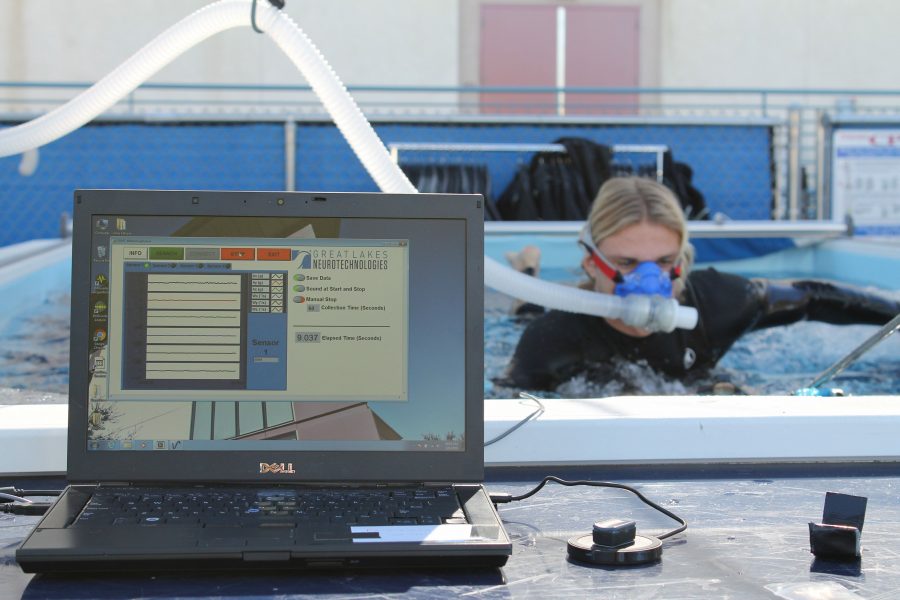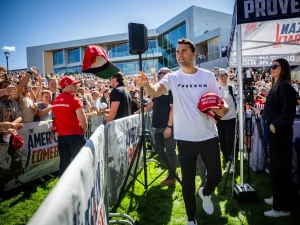Grad student spearheads latest surf research study
Under the tutelage kinesiology professors, Tayler Frazee explores science behind surfboard design
April 13, 2016
CSUSM grad student Tayler Frazee is leading the way with his unique research study on surfing that takes a critical look at surfboard design and metabolic efficiency of surfers.
The results, generated by monitoring surfers in an Endless Pool, could greatly expand the surf industry’s understanding of how to customize their boards to their consumers. It also increases researcher-based understanding on the subtle metabolic differences surfers experience on different boards.
The surf research department that Frazee works in is the brainchild of Associate Professor of Kinesiology Dr. Jeff Nessler and Assistant Professor of Kinesiology Dr. Sean Newcomer.
Nessler and Newcomer, who share Friday morning surf sessions, came up with the idea several years ago when surfing together.
“[We] started talking about surfing and how we could maybe implement this into the curriculum and also into collaborating and doing some projects on surfing because there’s really no data on it,” Newcomer said.
This simple conversation triggered the 2013 inception of surfing research at CSUSM.
“We actually have graduates that still work and do studies for us even though they have jobs—real jobs now. They still come back … they really do enjoy it,” Newcomer said.
The research of graduate students like Frazee aims to expand the knowledge of a sport that often gets neglected in favor of traditional sports such as football and baseball.
Frazee’s research, titled “Optimizing Metabolic Efficiency through Manipulation of Surfboard Design,” is one of the most recent projects to be completed. This tandem study looks at biomechanical specifications, such as oxygen intake and the performance of the surfer on the board.
The research used three test boards that were provided by Firewire Surfboards, which is owned by world-famous surfer Kelly Slater, that varied in distribution of volume.
Each of the 20 test subjects had a set amount of time on every Firewire board in the Endless Pool hiding behind Science Hall II.
The all-male test subjects, who for the most part each stood at approximately 5’8” and are 140 to 170 pounds, were introduced to the three boards at random.
Frazee, a lifetime surfer and former Cal Poly men’s water polo player, implemented the randomization of boards in order to avoid the problem of surfers reaching fatigue on the same board, knowing that would skew the results.
While there were other elements to the study, a timed activity stood out as the most time consuming part of the research.
In this portion, the surfers were hooked up to a monitor that measured their breathing as they paddled in the current of the Endless Pool. They paddled for three minutes and then sat and relaxed for another three minutes while the team monitored their vitals. They did this six minute test once for each board for a total of 18 minutes.
“The first round [of the paddling] was a little harder than expected,” said participant and CSUSM Surf Club member Sam Acosta. “There were a lot more measurements than I thought they would have.”
With the help of research assistants, Frazee completed the last batch of tests on Feb. 26, 2016. He is now submitting the research paper to an interdisciplinary CSUSM committee that includes Associate Professor of Biochemistry Sajith Jayasinghe and Professor of Biological Sciences Betsy Read.
Frazee’s study revealed that there was no statistical metabolic variance on the different boards. Despite a lack of statistical difference, the surfers noticed a change in the way their bodies felt on the different boards.
This reinforces one of Frazee’s biggest findings—that the personal feel on a board is a huge part of choosing a surfboard. Even though the study revealed a lack of statistical difference, the surfers themselves noticed differences.
When this research is brought back to Firewire, they will be able to see that the volume placement of each surfboard does not matter and that they truly need to be focusing on the individual surfer.
“[In surfing] you can’t rule out the human element because it’s so heavily influential,” Frazee said. “To each his own.”







